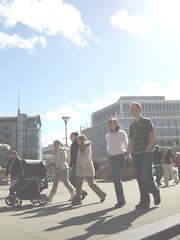
random folk
It was bad, reckless and yet at the same time totally invigorating. Unethical, dangerous and certainly an invasion of ‘publicy’, but after reading something from Iain Sinclair’s “Dining on Stones” I had to give it a go. Here’s a couple of extracts from his fiction to show you what I mean. An approach to photographing the everyday is described: “Once you break free of the traditional one-eyed stance, everything loosens up. You breech the middle ground. I abandoned the viewfinder as much too risky in Kingsland Waste Market, Clapton High Street, Green Lanes [….] I deactivated the flash and learned to frame by instinct. The result was a pleasing slapdash, unmediated aesthetic. [….] What are we really doing with those handheld obituary lanterns, our cameras?” What he describes seemed diametrically opposed to what I’ve been doing in the studies – colour, light, composition, close-up (dignifying the quotidian) – I just had to give it a go!
Division Street was disappointingly empty when I moored my bicycle to a nearby lamppost, but I’d already decided that I was going to steal some pictures of shoppers in town. I’d practised the method. Camera, nonchalantly cradled in the right hand; thumb casually covering the button. Looking at shop windows or trying to make eye contact, acting as casually as possible whilst surreptitiously firing away. Shooting from the hip... I got loads of people! Unsuspecting strangers. Odd angles, people in motion, hair caught by the wind, frozen in mid-stride, talking mid sentence, just about to change their minds - unfocused, blurred, bodged, unmediated. I came home through the back streets, like a hunter with prey, winding up through the brick streets brightly illuminated with graffiti with a feeling of satisfaction.
It was at that point that I recalled some John Berger that I read years back. Something on wildlife photography – the essay “Why look at animals?” in “About Looking” (also discussed and critiqued here), in fact. Berger argues about the separation of human kind from nature and from animals in particular. First we shoot them with guns (safari and trophy hunting); then we imprison them in zoos and shoot them with cameras; and finally we completely ruin their habitat and then they’re done for. Extinct. I wondered, then, how much photography distances us from our subjects – makes others into objects, and so on. And then I started to think how many people I’d shot today. A massacre. They were all done for. Just my twitching thumb, but I’d done something I now couldn’t undo….well I could, of course, simply delete them. I did that with the ugly ones. They were unceremoniously terminated. But I poured over the others, still somehow pleased with my work. Rich pickings, I thought. So OK, people, you’re under constant surveillance. You’re ‘publicy’ is under scrutiny. There are no ethics; someone’s always clicking. My Cybershot DSC-P73 is a silver bullet; I’m trigger happy. I know, shooting people is wrong, but let’s face it they’ve all been shot already. Countless times.
4 comments:
Interesting post. You can see the camera as doing so many things - as a mediator, a distancer, a framer and editor. Yet is also does a thing of showing you 'anew'; differently; more clearly. Many photographs show you a new way of seeing things organised.
Photography is usally done reasonably carefully, not like your thing you describe on this post. I must have a go of that.
Maybe it I like the difference between raw jamming jazz and orchestral, composed, classical music. All doing different things.
Full of admiration for your pre-planning and sang froid which helped you pull this off. I tried something similar in M&S at Christmas. I wanted to catch the miserable faces on folk wearing santa hats and selling turkey but forgot to de-activate my flash and got spotted by the ever vigilant floor manager, who warned me not to take shots of people. I mumbled something about keeping a record of what I was buying for futuure reference- but wasn't believed. Most of my Galapagos shots were taken on the run- but interestingly I only posted the carefully studied ones! Sometimes it looked as if the animals had learned to pose- see the picture of the booby on the rock, for example. Your post has given me the motivation to try again at homewith stealth photography.
Sorry you'll miss Sharrow lanterns but I am sure you'll find a way of escaping conference an 4xing it somewhere. Enjoy.
Interesting feeling, when you experiment with control and framing, isn't it? Our image-rich context teases us in the direction of pin-sharp focus, hyper-real colour, careful framing, a sort of reality make-over. Interesting our current "obituary lanterns" do most of this for us. Once it was a labour, now it's a patience of clicking and cropping. No more chemicals. Let's do some jamming, some rough-cuts, bring back the blur, the finger over the lens. Cut their heads off!
I wonder if lengthier posts invite lengthier comments?
Post a Comment